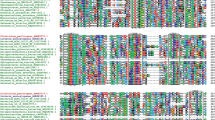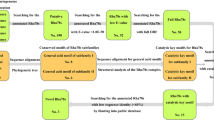ab]Abstract
C-Glycosides are an important type of natural product with significant bioactivities, and the C-glycosidic bonds of C-glycosides can be cleaved by several intestinal bacteria, as exemplified by the human faeces-derived puerarin-degrading bacterium Dorea strain PUE. However, glycoside hydrolases in these bacteria, which may be involved in the C-glycosidic bond cleavage of C-glycosides, remain largely unknown. In this study, the genomes of the closest phylogenetic neighbours of five puerarin-degrading intestinal bacteria (including Dorea strain PUE) were retrieved, and the protein-coding genes in the genomes were subjected to sequence similarity network (SSN) analysis. Only four clusters of genes were annotated as glycoside hydrolases and observed in the genome of D. longicatena DSM 13814T (the closest phylogenetic neighbour of Dorea strain PUE); therefore, genes from D. longicatena DSM 13814T belonging to these clusters were selected to overexpress recombinant proteins (CG1, CG2, CG3, and CG4) in Escherichia coli BL21(DE3). In vitro assays indicated that CG4 efficiently cleaved the O-glycosidic bond of daidzin and showed moderate β-D-glucosidase and β-D-xylosidase activity. CG2 showed weak activity in hydrolyzing daidzin and pNP-β-D-fucopyranoside, while CG3 was identified as a highly selective and efficient α-glycosidase. Interestingly, CG3 and CG4 could be selectively inhibited by daidzein, explaining their different performance in kinetic studies. Molecular docking studies predicted the molecular determinants of CG2, CG3, and CG4 in substrate selectivity and inhibition propensity. The present study identified three novel and distinctive glycoside hydrolases, highlighting the potential of SSN in the discovery of novel enzymes from genomic data.
Similar content being viewed by others
References
Atkinson, H.J., Morris, J.H., Ferrin, T.E., and Babbitt, P.C. 2009. Using sequence similarity networks for visualization of relationships across diverse protein superfamilies. PLoS ONE 4, e4345.
Bhandari, P., Tingley, J.P., Palmer, D.R., Abbott, D.W., and Hill, J.E. 2021. Characterization of an α-glucosidase enzyme conserved in Gardnerella spp. isolated from the human vaginal microbiome. J. Bacteriol. 203, e0021321.
Braune, A. and Blaut, M. 2011. Deglycosylation of puerarin and other aromatic C-glucosides by a newly isolated human intestinal bacterium. Environ. Microbiol. 13, 482–494.
Braune, A. and Blaut, M. 2012. Intestinal bacterium Eubacterium cellulosolvens deglycosylates flavonoid C- and O-glucosides. Appl. Environ. Microbiol. 78, 8151–8153.
Braune, A., Engst, W., and Blaut, M. 2016. Identification and functional expression of genes encoding flavonoid O- and C-glycosidases in intestinal bacteria. Environ. Microbiol. 18, 2117–2129.
Brown, S. and Babbitt, P. 2012. Inference of functional properties from large-scale analysis of enzyme superfamilies. J. Biol. Chem. 287, 35–42.
Chassard, C. and Lacroix, C. 2013. Carbohydrates and the human gut microbiota. Curr. Opin. Clin. Nutr. Metab. Care 16, 453–460.
Dong, J., Liang, Q., Niu, Y., Jiang, S., Zhou, L., Wang, J., Ma, C., and Kang, W. 2020. Effects of Nigella sativa seed polysaccharides on type 2 diabetic mice and gut microbiota. Int. J. Biol. Macromol. 159, 725–738.
Gerlt, J.A., Bouvier, J.T., Davidson, D.B., Imker, H.J., Sadkhin, B., Slater, D.R., and Whalen, K.L. 2015. Enzyme Function Initiative-Enzyme Similarity Tool (EFI-EST): a web tool for generating protein sequence similarity networks. Biochim. Biophys. Acta 1854, 1019–1037.
Hattori, M., Kanda, T., Shu, Y., Akao, T., Kobashi, K., and Namba, T. 1988a. Metabolism of barbaloin by intestinal bacteria. Chem. Pharm. Bull. 36, 4462–4466.
Hattori, M., Shu, Y.Z., el-Sedawy, A.I., Namba, T., Kobashi, K., and Tomimori, T. 1988b. Metabolism of homoorientin by human intestinal bacteria. J. Nat. Prod. 51, 874–878.
Hollman, P.C.H. 2001. Evidence for health benefits of plant phenols: local or systemic effects? J. Sci. Food Agric. 81, 842–852.
Huang, L., Zhang, H., Wu, P., Entwistle, S., Li, X., Yohe, T., Yi, H., Yang, Z., and Yin, Y. 2018. dbCAN-seq: a database of carbohydrate-active enzyme (CAZyme) sequence and annotation. Nucleic Acids Res. 46, D516–D521.
Ito, T., Fujimoto, S., Shimosaka, M., and Taguchi, G. 2014. Production of C-glucosides of flavonoids and related compounds by Escherichia coli expressing buckwheat C-glucosyltransferase. Plant Biotechnol. 31, 519–524.
Jin, J.S., Nishihata, T., Kakiuchi, N., and Hattori, M. 2008. Biotransformation of C-glucosylisoflavone puerarin to estrogenic (3S)-equol in co-culture of two human intestinal bacteria. Biol. Pharm. Bull. 31, 1621–1625.
Jyotshna, Khare, P., and Shanker, K. 2016. Mangiferin: a review of sources and interventions for biological activities. Biofactors 42, 504–514.
Kim, M., Lee, J., and Han, J. 2015. Deglycosylation of isoflavone C-glycosides by newly isolated human intestinal bacteria. J. Sci. Food Agric. 95, 1925–1931.
Kim, Y.S., Yeom, S.J., and Oh, D.K. 2011. Characterization of a GH3 family β-glucosidase from Dictyoglomus turgidum and its application to the hydrolysis of isoflavone glycosides in spent coffee grounds. J. Agric. Food Chem. 59, 11812–11818.
Levin, B.J., Huang, Y.Y., Peck, S.C., Wei, Y., Martínez-del Campo, A., Marks, J.A., Franzosa, E.A., Huttenhower, C., and Balskus, E.P. 2017. A prominent glycyl radical enzyme in human gut microbiomes metabolizes trans-4-hydroxy-L-proline. Science 355, eaai8386.
Ley, R.E., Turnbaugh, P.J., Klein, S., and Gordon, J.I. 2006. Human gut microbes associated with obesity. Nature 444, 1022–1023.
Li, X., Xia, W., Bai, Y., Ma, R., Yang, H., Luo, H., and Shi, P. 2018. A novel thermostable GH3 β-glucosidase from Talaromyce leycettanus with broad substrate specificity and significant soybean isoflavone glycosides-hydrolyzing capability. BioMed Res. Int. 2018, 4794690.
Nakamura, K., Komatsu, K., Hattori, M., and Iwashima, M. 2013. Enzymatic cleavage of the C-glucosidic bond of puerarin by three proteins, Mn2+, and oxidized form of nicotinamide adenine dinucleotide. Biol. Pharm. Bull. 36, 635–640.
Nakamura, K., Nishihata, T., Jin, J.S., Ma, C.M., Komatsu, K., Iwashima, M., and Hattori, M. 2011. The C-glucosyl bond of puerarin was cleaved hydrolytically by a human intestinal bacterium strain PUE to yield its aglycone daidzein and an intact glucose. Chem. Pharm. Bull. 59, 23–27.
Nakamura, K., Zhu, S., Komatsu, K., Hattori, M., and Iwashima, M. 2019. Expression and characterization of the human intestinal bacterial enzyme which cleaves the C-glycosidic bond in 3″-oxopuerarin. Biol. Pharm. Bull. 42, 417–423.
Nakamura, K., Zhu, S., Komatsu, K., Hattori, M., and Iwashima, M. 2020. Deglycosylation of the isoflavone C-glucoside puerarin by a combination of two recombinant bacterial enzymes and 3-oxoglucose. Appl. Environ. Microbiol. 86, e00607–20.
Pei, X., Zhao, J., Cai, P., Sun, W., Ren, J., Wu, Q., Zhang, S., and Tian, C. 2016. Heterologous expression of a GH3 β-glucosidase from Neurospora crassa in Pichia pastoris with high purity and its application in the hydrolysis of soybean isoflavone glycosides. Protein Expr. Purif. 119, 75–84.
Qu, X., Ding, B., Li, J., Liang, M., Du, L., Wei, Y., Huang, R., and Pang, H. 2020. Characterization of a GH3 halophilic β-glucosidase from Pseudoalteromonas and its NaCl-induced activity toward isoflavones. Int. J. Biol. Macromol. 164, 1392–1398.
Seong, S.H., Roy, A., Jung, H.A., Jung, H.J., and Choi, J.S. 2016. Protein tyrosine phosphatase 1B and α-glucosidase inhibitory activities of Pueraria lobata root and its constituents. J. Ethnopharmacol. 194, 706–716.
Thursby, E. and Juge, N. 2017. Introduction to the human gut microbiota. Biochem. J. 474, 1823–1836.
Valles-Colomer, M., Falony, G., Darzi, Y., Tigchelaar, E., Wang, J., Tito, R.Y., Schiweck, C., Kurilshikov, A., Joossens, M., Wijmenga, C., et al. 2019. The neuroactive potential of the human gut microbiota in quality of life and depression. Nat. Microbiol. 4, 623–632.
Wang, S., Zhang, S., Wang, S., Gao, P., and Dai, L. 2020. A comprehensive review on Pueraria: Insights on its chemistry and medicinal value. Biomed. Pharmacother. 131, 110734.
Wei, B., Wang, Y.K., Qiu, W.H., Wang, S.J., Wu, Y.H., Xu, X.W., and Wang, H. 2020. Discovery and mechanism of intestinal bacteria in enzymatic cleavage of C-C glycosidic bonds. Appl. Microbiol. Biotechnol. 104, 1883–1890.
Wei, B., Yang, W., Yan, Z.X., Zhang, Q.W., and Yan, R. 2018. Prenyl-flavonoids sanggenon C and kuwanon G from mulberry (Morus alba L.) as potent broad-spectrum bacterial β-glucuronidase inhibitors: biological evaluation and molecular docking studies. J. Funct. Foods 48, 210–219.
Wei, J., Zhang, X.Y., Deng, S., Cao, L., Xue, Q.H., and Gao, J.M. 2017. α-Glucosidase inhibitors and phytotoxins from Streptomyces xanthophaeus. Nat. Prod. Res. 31, 2062–2066.
Wu, H., Rebello, O., Crost, E.H., Owen, C.D., Walpole, S., Bennati-Granier, C., Ndeh, D., Monaco, S., Hicks, T., Colvile, A., et al. 2020. Fucosidases from the human gut symbiont Ruminococcus gnavus. Cell. Mol. Life Sci. 78, 675–693.
Xu, J., Qian, D., Jiang, S., Guo, J., Shang, E., Duan, J., and Yang, J. 2014. Application of ultra-performance liquid chromatography coupled with quadrupole time-of-flight mass spectrometry to determine the metabolites of orientin produced by human intestinal bacteria. J. Chromatogr. B Analyt. Technol. Biomed. Life Sci. 944, 123–127.
Yoon, S.H., Ha, S.M., Kwon, S., Lim, J., Kim, Y., Seo, H., and Chun, J. 2017. Introducing EzBioCloud: a taxonomically united database of 16S rRNA and whole genome assemblies. Int. J. Syst. Evol. Microbiol. 67, 1613–1617.
Zallot, R., Oberg, N., and Gerlt, J.A. 2019. The EFI web resource for genomic enzymology tools: leveraging protein, genome, and metagenome databases to discover novel enzymes and metabolic pathways. Biochemistry 58, 4169–4182.
Zhou, T.S., Wei, B., He, M., Li, Y.S., Wang, Y.K., Wang, S.J., Chen, J.W., Zhang, H.W., Cui, Z.N., and Wang, H. 2020. Thiazolidin-2-cyanamides derivatives as novel potent Escherichia coli β-glucuronidase inhibitors and their structure-inhibitory activity relationships. J. Enzyme Inhib. Med. Chem. 35, 1736–1742.
Acknowledgements
This work was financially supported by the National Key Research and Development Program (2017YFE0103100), the programs of the National Natural Science Foundation of China (No. 81903534, No. 81773628, and No. 81741165), the High-Level Talent Special Support Plan of Zhejiang Province (No. 2019R52009) and the Scientific Research Fund of Second Institute of Oceanography, State Oceanic Administration (JB2002).
Author information
Authors and Affiliations
Contributions
HW and XX conceived and designed the study. BW and YW conducted experiments and wrote the manuscript. JY and SW contributed analytical tools and analyzed data. YY revised the manuscript. All the authors read and approved the manuscript.
Corresponding authors
Ethics declarations
All authors declare no conflicts of interest. This article does not contain any studies with human participants performed by any of the authors.
Additional information
Supplemental material for this article may be found at http://www.springerlink.com/content/120956.
Electronic supplementary material
Rights and permissions
About this article
Cite this article
Wei, B., Wang, YK., Yu, JB. et al. Discovery of novel glycoside hydrolases from C-glycoside-degrading bacteria using sequence similarity network analysis. J Microbiol. 59, 931–940 (2021). https://doi.org/10.1007/s12275-021-1292-4
Received:
Revised:
Accepted:
Published:
Issue Date:
DOI: https://doi.org/10.1007/s12275-021-1292-4




